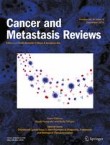|
Anapafseos 5 Agios Nikolaos 72100,Crete,Greece,00302841026182,00306932607174,alsfakia@gmail.com
Blog Archive
- ► 2022 (3010)
- ► 2021 (9899)
-
▼
2020
(4138)
-
▼
November
(1979)
-
▼
Nov 23
(100)
- Long-term Oncologic Impact of Positive Anterior an...
- Trends in Primary Surgical Resection and Chemother...
- Comparing Late-line Treatment Sequence of Regorafe...
- Characterization of a Novel Entity of G3 (High-gra...
- Effect of Age on Cancer-specific Mortality in Pati...
- Brain Radiation Induced Extracranial Abscopal Effe...
- Adjuvant Trastuzumab Emtansine (T-DM1) and Concurr...
- SBRT in non-spine bone metastases: a literature re...
- Validity and reliability of the MD Anderson dyspha...
- Somatic Epigenetic Silencing of RIPK3 Inactivates ...
- Entinostat plus pembrolizumab in patients with met...
- Meta-analysis of laparoscopic versus open liver re...
- PNN and KCNQ1OT1 can predict the efficacy of adjuv...
- Ubiquitin ligase DTX3 empowers mutant p53 to promo...
- Survival outcomes of acute normovolemic hemodiluti...
- HE4 and CA125 as preoperative risk stratifiers for...
- Patient Navigation to Improve Early Access to Supp...
- A phase Ib study of NUC-1031 in combination with c...
- Standardized supportive care documentation improve...
- Tumor frameshift mutation proportion predicts resp...
- Plasma levels of platinum-induced fatty acid [16:4...
- Phase I trial of nedaplatin and S-1 in patients wi...
- Comparison of the prognostic value of MUST, ECOG-P...
- End-of-Life Care: Use of Antineoplastic Therapy an...
- Genetic Biomarkers: Implications of Increased Unde...
- PDK4 promotes tumorigenesis and cisplatin resistan...
- Colorectal Cancer Screening in the Elderly.
- Vitamin D in Head and Neck Cancer: a Systematic Re...
- Osteoporosis after adjuvant treatment for early-st...
- Comparison between temporal and rectal temperature...
- An amperometric biosensor of L-fucose in urine for...
- Comparison of effectiveness and safety outcomes of...
- Calf deep vein thrombosis: frequency, therapeutic ...
- PNN and KCNQ1OT1 can predict the efficacy of adjuv...
- Feasibility of simulation contrast-enhanced comput...
- Rho GTPases in cancer radiotherapy and metastasis
- The effects of mutant Ras proteins on the cell sig...
- Splice variants of RAS—translational significance
- Dynamically encoded reactivity of Ras enzymes: ope...
- Current therapy of advanced colorectal cancer acco...
- Platelets in aging and cancer—“double-edged sword”
- Gastric cancer: a comprehensive review of current ...
- A perspective on the early days of RAS research
- Current therapy of KRAS-mutant lung cancer
- Molecular mediators of peritoneal metastasis in pa...
- Molecular epidemiology and diagnostics of KRAS mut...
- Small molecule inhibitors of RAS proteins with onc...
- Structure-based inhibitor design of mutant RAS pro...
- Finding incident cancer cases through outpatient o...
- microRNA-211-mediated targeting of the INHBA-TGF-β...
- The inhibition effect of natural food supplement a...
- Prognostic Value of Soluble Programmed Cell Death ...
- microRNA-211-mediated targeting of the INHBA-TGF-β...
- Dose Fractionation During Puberty is More Detrimen...
- Isotoxic Intensity Modulated Radiotherapy in stage...
- Polymorphonuclear-MDSCs facilitate tumor regrowth ...
- The quality of reporting general safety parameters...
- Modification of the 8th American Joint Committee o...
- Interferon-lambda ( IFNL ) germline variations and...
- Hepatocellular carcinoma: Intratumoral EpCAM-posit...
- Phase 1 Trial of LVGN7409 (CD40 Agonist Antibody) ...
- Camrelizumab Combined With Chemotherapy for Recurr...
- A Study on the Safety and Effectiveness of IBI318 ...
- ARGONAUT: Stool and Blood Sample Bank for Cancer P...
- Tramadol Hydrochnoride as Adjuvant to Local Anesth...
- Genetically Engineered Cells (MAGE-A1-specific T C...
- Anti-angiogenic Agents Plus Anti-PD-1 Antibodies f...
- CLL Induction Treatment With Venetoclax and Ibruti...
- Identification of Genetic Determinants for Treatme...
- Pembrolizumab as Neoadjuvant Therapy for Resectabl...
- Intestinal Microbiota in Prostate Cancer Patients ...
- Anti-CD19 FasT CAR-T Cell Therapy for B Cell NHL
- Pyrotinib, Trastuzumab And Abraxane in HER2-positi...
- Impact of (Neo)Adjuvant Therapy Associating Anthra...
- De-Escalation Protocol Of HPV Mediated Oropharynge...
- PREselection of Patients at Risk for COgnitive DEc...
- OH2 Oncolytic Viral Therapy in Pancreatic Cancer
- Silicon Microsieve Device vs Cell Surface Marker-b...
- A Study to Evaluate Camrelizumab Plus Apatinib as ...
- Fluorescence Molecular Endoscopy and Molecular Flu...
- Identification and validation of a six-gene signat...
- Risk stratification for prediction of locoregional...
- Association between five types of Tumor Necrosis F...
- STAT3 regulates miR93-mediated apoptosis through i...
- Genomics and prognosis analysis of epithelial-mese...
- Overriding sorafenib resistance via blocking lipid...
- Development and validation of an RNA binding prote...
- STAT3 regulates miR93-mediated apoptosis through i...
- Optimizing the use of telemedicine in oncology car...
- Safety and clinical activity of a new anti-PD-L1 a...
- Combined Inhibition of G{alpha}q and MEK Enhances ...
- Therapeutic potential of NTRK3 inhibition in desmo...
- Recommendation regarding the cranial upper border ...
- Impact of prior cancer history on the survival of ...
- Whole-brain irradiation differentially modifies ne...
- The impact of lifecourse socio-economic position a...
- High cumulative doxorubicin dose for advanced soft...
- Bladder cancer stage and mortality: urban vs. rura...
- Circ-ZNF124 downregulation inhibits non-small cell...
- Weekly versus triweekly cisplatin-alone adjuvant c...
-
▼
Nov 23
(100)
-
▼
November
(1979)
- ► 2019 (2429)
Αλέξανδρος Γ. Σφακιανάκης
Monday, November 23, 2020
Dynamically encoded reactivity of Ras enzymes: opening new frontiers for drug discovery
Subscribe to:
Post Comments (Atom)



No comments:
Post a Comment